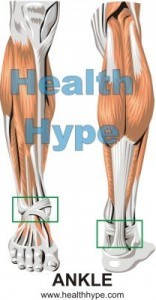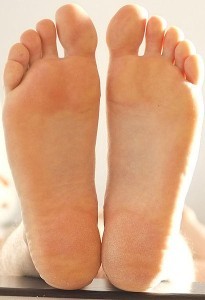How To Protect And Strengthen Weak Ankles
Weak ankles is a common term that many people use to refer to ankle pain, ankle instability and repeated ankle sprains. It is not always a problem with the strength of the ankle joint as much as a strain by walking incorrectly or using improper footwear. However, for some people the ankles may in fact be “weak” for their body weight. Repeated rolling and twisting of the ankle (even if the pain and swelling of a sprain does not arise) can be quite disconcerting and even strike fear when walking around during the course of a regular day.
The ankles are joints that have to contend with great strain everyday. It has to bear almost the entire body weight (except for the feet) when standing in addition to being strong enough to withstand the impact of walking and running. As with other joints, it is made up of bones, is capped with cartilage and surrounded by a capsule. The strength of the ankle joint is dependent on many structures including the ligaments, tendons and muscles around it.
Why do ankles weaken?
Weak ankles is primarily a problem with ankle stability. It is not usually caused by weakening of the bones involved in the ankle joint or the ligaments and structures that keep it stable. Although these structural problems are a possibility, more often than not weakening of the ankles is a result of the way you distribute your body weight through your feet. Eventually it can affect the structures of the ankle joint and it may even cause a permanent change. Apart from pain, the instability can lead to falls which may result in more severe injuries like a fracture.
Weight Distribution
Some people tend to place more weight on the outer (lateral) part of the soles of the feet. Others may place more weight on the inner (media) part of the feet. It is not so much of a problem when standing but rather when walking and running. The ankle is more likely to be placed under greater strain when planting the foot and shifting the body weight to the leg during each step.
Overweight or Obese
Another factor is your body weight. While the joint compensates to some degree to take greater strain if your body weight increase, the degree to which it can compensate is limited. A moderate weight gain may not be a major problem but significant weight gain can drastically impact on the joints which have not developed to cater for this additional weight. The ankles and knees are particularly affected.
Sprain and Pain
These are just some of the reasons why your ankle may feel weak. If the injury to the supporting structures of the ankle joint are severe then inflammation may set in. This leads to persistent swelling and pain. An ankle sprain is one common such occurrence. Here the ligaments get stretched and twisted. However, even without a sprain you can repeatedly strain your ankle with only momentary ankle pain.
Get The Correct Footwear Advice
Your shoes can assist with weak ankles but getting the correct footwear may mean turning your back on fashion and personal preferences. High heels for one will have to go. The key is finding a shoe that allows your body weight to be distributed equally across the sole of your feet. Flat soled shoes with good support for the arches are a better option. But before you change all your footwear, it is advisable to get proper advice from a podiatrist.
Consider In-Soles For Your Shoes
You may not have to throw away all your shoes. The right type of insole designed specifically for your feet can make a major difference in reducing the strain on the ankles. Insoles are the inner bottom part of the shoe that is in contact with your feet. When correctly designed it can help with distributing your body weight equally and providing arch support. You should speak to a podiatrist who will then work with other health professionals in getting the right insoles for your feet.
Use An Ankle Brace Or Taping
Many people find that an ankle support or brace is a quick and easy solution to remedying weak ankles. Some are more rigid, others very flexible. It can be easily attached and removed, and has become relatively inexpensive so it can be changed frequently. These braces work by providing support from the outside. By throughly firmly adhering the lower limb, it acts in a similar way to the tendons and ligaments that naturally strengthen the ankle joint. Taping, or strapping, is another technique to provide temporary support to the ankle joint. It is useful for limiting further strain while providing support after an injury. Taping should ideally be done by a physical therapist.
Try To Return To A Normal BMI
If you are overweight or obese and experiencing ankle problems, then you will seriously have to make an effort to lose weight. It is just as important for your ankle as it is for the rest of your body. Although the body is able to contend with a little extra weight for a short period, over time the additional force strains the ankle joint and can cause structural damage. Exercise is an important part of any weight loss program but do not start activities like walking straight away if you have weak ankles. The impact on the joint can do more harm than good. Speak to a doctor and look at exercises that will not place additional strain on the joint. Swimming is one such option.
Be Conscious About Your Gait
We all have a unique way of walking. This is known as the gait. None of us have a perfect gait but usually it is not defective to the point where it causes any significant damage to the joints. However, people with weak ankles may have a gait that is contributing to ankle problems and the gait therefore needs to be corrected. You will have to first understand where and how you gait needs to be improved and then remain conscious about it every time you move around. Make the necessary corrections each time you spot that you have returned to your prior defective gait. It will take time but it is possible to correct the gait.
See A Physical Therapist and Podiatrist
It is important to seek medical attention if you do have weak ankles or experience repeated ankle sprains. Symptoms like ankle pain, swelling and redness of the overlying skin needs to be assessed by a medical professional. Apart from your family doctor, two other practitioners who can help guide you on how to protect and strengthen your ankles are a physical therapist and podiatrist. Even if the symptoms like pain, swelling and shakiness resolve, both a practitioners will assist in helping your ankles strengthen over time and ultimately for the ankle stability to return to normal where possible.







